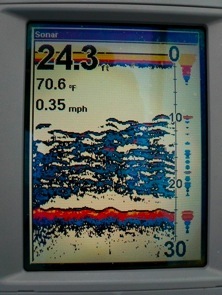 It’s sometimes said that good fishermen think like a fish. While no one really knows what fish think, it’s usually possible to predict where they might be located based on climatic conditions and the time of year. Two very important factors to consider when looking for fish in the Chesapeake Bay are water temperature and salinity. Sometimes stripers congregate near underwater structure, at other times they travel in schools out in the open bay, but they always prefer specific depth zones which vary depending on the time of year. Fish are cold-blooded, so they’re more likely to be active in water that keeps them warmer in the winter and cooler in the summer. The “perfect” water temperature for stripers is around 68 degrees, but perfect conditions are rare. Since locating feeding fish is a fisherman’s primary challenge, it’s important to understand seasonally changing temperature zones in the Bay.
It’s sometimes said that good fishermen think like a fish. While no one really knows what fish think, it’s usually possible to predict where they might be located based on climatic conditions and the time of year. Two very important factors to consider when looking for fish in the Chesapeake Bay are water temperature and salinity. Sometimes stripers congregate near underwater structure, at other times they travel in schools out in the open bay, but they always prefer specific depth zones which vary depending on the time of year. Fish are cold-blooded, so they’re more likely to be active in water that keeps them warmer in the winter and cooler in the summer. The “perfect” water temperature for stripers is around 68 degrees, but perfect conditions are rare. Since locating feeding fish is a fisherman’s primary challenge, it’s important to understand seasonally changing temperature zones in the Bay.
Salinity and temperature are closely related in the Bay. Striped bass are classified as anadromous fish, meaning they live primarily in salt water but migrate to fresh water to spawn. While they can live and thrive in fresh water, they prefer water with some salinity. Scientific opinions are mixed as to the optimum salt content, but there’s no denying that salinity influences the behavior of rockfish in the Bay. This is especially true in the spring and fall when many fish are traveling to and from the ocean.
The Bay is a giant mixing bowl of varying water temperatures and salinity levels. Freshwater bass fishermen have long recognized the importance of locating optimum temperature zones for fish. The added factor of salt, coupled with relatively shallow water in the Bay, throws additional considerations into the equation and makes locating fish more challenging. While fishing the TVA lakes of the Southeast, I learned that fish would sacrifice food requirements in favor of more temperate feeding zones. In other words, they would rather eat a little in comfortable water than a lot in water they don’t like. I think the same holds true with salinity. Finding comfortable temperature layers where the water contains the optimum amount of salt is key to successful light tackle fishing in the Bay.
Stratification
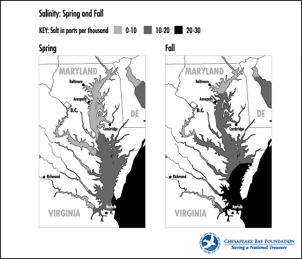 The three most important physical characteristics of the water in the Chesapeake Bay are salinity, temperature, and circulation. These characteristics interact to vary the life-sustaining dynamics of the ecosystem. The Bay is saltiest near its mouth at the Atlantic Ocean, while the freshest water is found in the rivers near the headwaters. Water warms mo
The three most important physical characteristics of the water in the Chesapeake Bay are salinity, temperature, and circulation. These characteristics interact to vary the life-sustaining dynamics of the ecosystem. The Bay is saltiest near its mouth at the Atlantic Ocean, while the freshest water is found in the rivers near the headwaters. Water warms mo
re quickly in the shallower regions during the spring and summer. As the fresher, warmer water flows toward the sea it begins to float on top of the denser salt water creating layers or stratification. In the spring, stratification becomes more defined, as heavy rains and melting snow in the upper Susquehanna Valley cause large amounts of fresh water to enter the Bay. In late spring through summer, the water is naturally warmer near the surface than it is in the deep. The area where the water mixes and the temperature changes is similar to a thermocline in freshwater systems. In the Bay, this zone is classified as a pycnocline because of the salinity factor.
The pycnocline is usually visible on most fish finders and sonar units as a thin line or layer in the water column. Sometimes small solid particles become trapped near the area where the density of the water changes. The reflections of these particles show up as many small marks on a sonar unit, making the temperature break even more obvious. It’s often necessary to increase the gain (sensitivity) of the unit to better identify the pycnocline. Even when the layering is not easily visible on the screen, it can be distinguished by observing the depth at which most of the baitfish are holding. They’ll congregate at the depth where the temperature and salinity of the water is most comfortable. This may not be the optimum depth for stripers, but you can be sure they won’t be far away.
Turnover
The spring and fall turnovers are especially important events to the light tackle fishermen. Turnover occurs when the temperature/density of the top layer of water changes enough to sink through the bottom layer. It can happen as quickly as overnight or it can take as long as a couple of weeks, but turnover usually happens in different parts of the Bay at different times. Turnovers are good for the Bay because they bring nutrients up from the bottom and distribute them throughout the water column providing food and forage for baitfish and other small organisms. Turnovers also affect water clarity and color, but more importantly, they affect the depth at which fish actively feed.
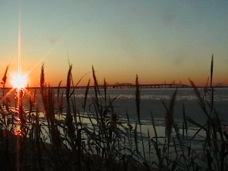 The fall turnover usually occurs in October or November in the Chesapeake Bay. As cold fronts begin sweeping down through the Mid-Atlantic region, wind and wave action helps cool surface waters until they are colder than the waters beneath them. Eventually the density of the water near the surface will change enough to sink. The fall turnover is usually very rapid and is often associated with a storm or strong cold front. The result is a mixing of temperatures and salinity that are fairly consistent throughout, and fish begin to feed at virtually any depth.
The fall turnover usually occurs in October or November in the Chesapeake Bay. As cold fronts begin sweeping down through the Mid-Atlantic region, wind and wave action helps cool surface waters until they are colder than the waters beneath them. Eventually the density of the water near the surface will change enough to sink. The fall turnover is usually very rapid and is often associated with a storm or strong cold front. The result is a mixing of temperatures and salinity that are fairly consistent throughout, and fish begin to feed at virtually any depth.
The spring turnover is less dramatic and closely related to the freshening of the Bay’s waters due to runoff from the rivers and streams, or the freshet. It is most often caused by flooding or melting snow in the upstream rivers that results in plumes of muddy water that can stretch far down into the Bay. Prior to the freshet, the warmer water settles deep, while cooler water or ice stays on the surface. There is very little scientific documentation of winter stratification in the Bay, but old-timers and watermen will tell you that fish stay deep until the influx of fresh water starts mixing things up.
Overall Warming
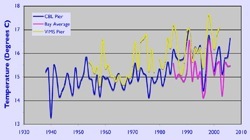 There is undeniable scientific evidence showing that the Chesapeake Bay is getting warmer. In fact, average seasonal temperatures have increased as much as two degrees Fahrenheit in the past 50 years. The continued warming of the water has changed the behavior of many species – including rockfish – that inhabit the area. Just like pelicans and geese, more stripers are staying in the Bay through the winter. Warmer water is also
There is undeniable scientific evidence showing that the Chesapeake Bay is getting warmer. In fact, average seasonal temperatures have increased as much as two degrees Fahrenheit in the past 50 years. The continued warming of the water has changed the behavior of many species – including rockfish – that inhabit the area. Just like pelicans and geese, more stripers are staying in the Bay through the winter. Warmer water is also
altering their behavior in other seasons. Some areas that may have been prime striper habitat in earlier years are no longer good fishing spots, while other locations that fish avoided in the past are now yielding impressive catches. It is important to recognize long-term trends in the behavioral patterns of fish in order to catch them consistently throughout the year.
Fishing through the seasons – Winter
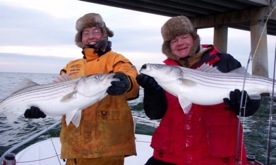 Catch-and-release light tackle fishing in the Chesapeake Bay is a pursuit that can currently be enjoyed year-round. In the winter, because fish look for warmer water, it is important to know the regional “hotspots” where temperatures are higher. These hotspots often result out of man-made sources such as industry or utilities that discharge warm water into the Bay. Since water temperatures are naturally very cold in winter, any water emitted from an industrial source will be a few degrees warmer. This is the time to fish the power plant discharges or factory discharges in area rivers. In addition to schooling near the warm water discharges, wintering-over rockfish now hold in deep pockets in the main stem of the Bay throughout the winter. With a little persistence, they can be induced to bite as they occasionally forage for baitfish.
Catch-and-release light tackle fishing in the Chesapeake Bay is a pursuit that can currently be enjoyed year-round. In the winter, because fish look for warmer water, it is important to know the regional “hotspots” where temperatures are higher. These hotspots often result out of man-made sources such as industry or utilities that discharge warm water into the Bay. Since water temperatures are naturally very cold in winter, any water emitted from an industrial source will be a few degrees warmer. This is the time to fish the power plant discharges or factory discharges in area rivers. In addition to schooling near the warm water discharges, wintering-over rockfish now hold in deep pockets in the main stem of the Bay throughout the winter. With a little persistence, they can be induced to bite as they occasionally forage for baitfish.
Spring
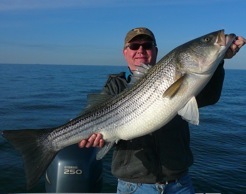 As winter ends and the spring rockfish migration begins, the water may still be warmer and saltier down deep. There can be baitfish throughout the water column, but stripers will feed more actively where the water is warm. This is usually about the time gannets – large white diving birds with black flashes on their wings – start appearing in the mid-Bay. These birds migrate south to the mid-Atlantic in the winter from their nesting grounds in Nova Scotia. While gannets can easily dive 50 feet deep into the water, they prefer to dive shallower where the fish start concentrating bait. As schools of bait try to escape attacking rockfish, they swim closer to the surface where they are easier pickings for the birds. As the gannets start circling and dive-bombing beak-first from the sky, more birds arrive and the feeding frenzy intensifies, creating a whirlwind of wings and feathers. Catching big fish in the midst of a gannet storm is one of the most exciting experiences for a Chesapeake Bay fisherman.
As winter ends and the spring rockfish migration begins, the water may still be warmer and saltier down deep. There can be baitfish throughout the water column, but stripers will feed more actively where the water is warm. This is usually about the time gannets – large white diving birds with black flashes on their wings – start appearing in the mid-Bay. These birds migrate south to the mid-Atlantic in the winter from their nesting grounds in Nova Scotia. While gannets can easily dive 50 feet deep into the water, they prefer to dive shallower where the fish start concentrating bait. As schools of bait try to escape attacking rockfish, they swim closer to the surface where they are easier pickings for the birds. As the gannets start circling and dive-bombing beak-first from the sky, more birds arrive and the feeding frenzy intensifies, creating a whirlwind of wings and feathers. Catching big fish in the midst of a gannet storm is one of the most exciting experiences for a Chesapeake Bay fisherman.
As the days get warmer and ospreys return to the Bay from their South American wintering grounds, temperatures briefly stabilize throughout the water column and the stratification process reverses. During the freshening, saltier water often channels along the shorelines on the east side of the Bay. Migrating stripers start to move closer to the surface and sometimes swim along these salt channels on their journeys toward their spawning grounds. Occasionally, schools of feeding fish will break on the surface during this time of year. Finding big migratory stripers surface feeding in the spring is a well-deserved reward for enduring the cold and windy days of winter.
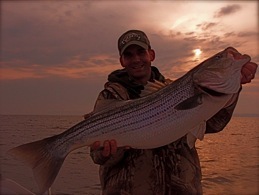 The change of the seasons is also the time when shallow water near the headwaters of the Bay starts to warm enough for fish to spawn. Almost all of the spawning areas are closed to spring fishing, but there are still plenty of areas nearby where fish can be caught and released. Stripers won’t eat when they’re spawning, but they feed voraciously just before and after in the warmest water they can find. Spring is the best time to fish the wide-shallow Susquehanna Flats, where thirty to fifty pound rockfish can be caught in as little as two feet of water. A good rule of thumb for this time of year is “find the warm water – find the fish.” Sometimes a mere break of one or two degrees can make the difference between catching and casting. Look for bigger fish in the sun-soaked spots of very shallow water.
The change of the seasons is also the time when shallow water near the headwaters of the Bay starts to warm enough for fish to spawn. Almost all of the spawning areas are closed to spring fishing, but there are still plenty of areas nearby where fish can be caught and released. Stripers won’t eat when they’re spawning, but they feed voraciously just before and after in the warmest water they can find. Spring is the best time to fish the wide-shallow Susquehanna Flats, where thirty to fifty pound rockfish can be caught in as little as two feet of water. A good rule of thumb for this time of year is “find the warm water – find the fish.” Sometimes a mere break of one or two degrees can make the difference between catching and casting. Look for bigger fish in the sun-soaked spots of very shallow water.
As spawned-out stripers begin to migrate back toward the ocean, temperature stratification is increasing throughout the Bay. The fish will avoid cooler deeper water and feed closer to the surface. Once surface temperatures reach the 60-degree mark, top-water plugs become the bait of choice for light tackle anglers. This is my favorite time of year to fish the Bay. There’s nothing more exciting that watching a huge rockfish explode on a surface lure.
Summer
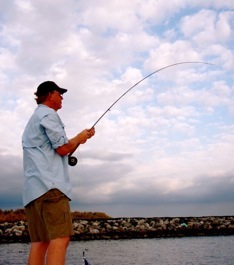 As summer approaches and water continues to warm, Chesapeake
As summer approaches and water continues to warm, Chesapeake
Bay rockfish begin a pattern of foraging in slightly deeper water, usually around the edges of oyster beds and underwater structure. Humps, lumps, ditches, and ledges between 15- and 25-feet deep are my favorite fishing spots in early summer. This is the time for jigging smaller soft-plastic baits or spoons, although a good fisherman knows to keep an eye out for breaking schools as they become more numerous. Top water fishing is most productive in the morning or evening.
During the hottest days of summer, water temperatures can be as much as 20 degrees cooler down deep. Fish will move deeper and become more dormant during the heat of the day but will feed actively in the early morning, late evening, and cool of the night. While small fish breaking on the surface can be fun to play around with, the best bet for catching big fish is to jig around deep structure. This is my favorite time to fish around bridge columns or wrecks as long as they’re deep enough to be beneath the pycnocline. A good sonar unit is one of the most essential tools for identifying the temperature break in the Bay. Spotting this dividing line in the water is a critical element of good summer fishing.
Fall
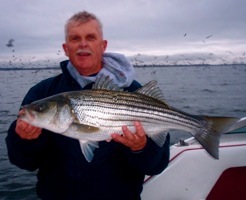 During the fall, as surface temperatures on the Bay start to cool, fish move to shallower water. This is the time of year a fisherman is most likely to encounter acres of breaking fish. “Running and gunning” looking for clouds of frenzied seagulls or terns is the order of the day. The mouths of the rivers turn on as big stripers set up ambush points from which to attack schools of baitfish that are moving out toward warmer water. Casting top-water lures to shoreline structure is also productive, as big fish move into the shallows to feed up for the coming winter.
During the fall, as surface temperatures on the Bay start to cool, fish move to shallower water. This is the time of year a fisherman is most likely to encounter acres of breaking fish. “Running and gunning” looking for clouds of frenzied seagulls or terns is the order of the day. The mouths of the rivers turn on as big stripers set up ambush points from which to attack schools of baitfish that are moving out toward warmer water. Casting top-water lures to shoreline structure is also productive, as big fish move into the shallows to feed up for the coming winter.
In late fall, striped bass that are migrating south down the Atlantic coast venture into the Bay to chase schools of baitfish swimming out of the rivers. After the turnover, when temperatures are relatively stable at any depth, these fish can be caught throughout the water column. Depending on local conditions, they might be stacked up close to structure or they might be breaking on the surface. As the water continues to cool, fish will move deeper until they resume their winter pattern of holding near the bottom.
The Mixing Bowl
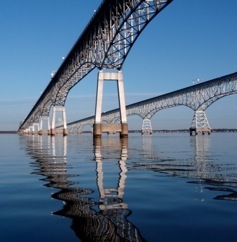 There are some locations in the Chesapeake Bay where turbulence causes temperatures and salinity to blend. This happens most often close to the mouths of the major rivers. Although these “mixing bowls” are well known to fishermen, scientists and marine biologists have only recently started to study them. Known as hydraulic control points, this phenomenon occurs when fresh water from streams blends with the saltiness of the main stem of the Bay to create pockets of nutrient-rich water. Because of the amplification in the biological process, these areas are very important to the overall health of the Bay. In fact, striped bass use them as nurseries. There are often thousands of small fish feeding around the rips and underwater currents that develop near the mouths of the rivers.
There are some locations in the Chesapeake Bay where turbulence causes temperatures and salinity to blend. This happens most often close to the mouths of the major rivers. Although these “mixing bowls” are well known to fishermen, scientists and marine biologists have only recently started to study them. Known as hydraulic control points, this phenomenon occurs when fresh water from streams blends with the saltiness of the main stem of the Bay to create pockets of nutrient-rich water. Because of the amplification in the biological process, these areas are very important to the overall health of the Bay. In fact, striped bass use them as nurseries. There are often thousands of small fish feeding around the rips and underwater currents that develop near the mouths of the rivers.
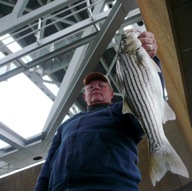 The area in the immediate vicinity of the Bay Bridge is the biggest mixing bowl on the Bay. Water in this area is in a constant state of flux, due to the proximity of several large fresh-water rivers, the geophysical narrowing of the Bay, and the turbulence created by the structure of the bridge. Scientists refer to this area of the Bay as the Estuarine Turbidity Maximum or ETM. I like to call it “Light Tackle University,” because anglers can encounter almost any fishing situation the Bay has to offer in just a few square miles. The frequently changing conditions in this area require the light tackle fisherman to stay alert and to be open to experimentation as specific feeding patterns constantly morph into new ones.
The area in the immediate vicinity of the Bay Bridge is the biggest mixing bowl on the Bay. Water in this area is in a constant state of flux, due to the proximity of several large fresh-water rivers, the geophysical narrowing of the Bay, and the turbulence created by the structure of the bridge. Scientists refer to this area of the Bay as the Estuarine Turbidity Maximum or ETM. I like to call it “Light Tackle University,” because anglers can encounter almost any fishing situation the Bay has to offer in just a few square miles. The frequently changing conditions in this area require the light tackle fisherman to stay alert and to be open to experimentation as specific feeding patterns constantly morph into new ones.
Summary
Many fishermen take the changing conditions in the Bay for granted. Few of us have the good fortune or the flexibility to plan our trips around the most productive conditions, but it is possible to optimize fishing any time of year with a better understanding of the ecosystem. It’s easy to catch fish when they’re feeding and the bite is on, but the ability to be productive on the slow days is what separates the good fishermen from the occasionally lucky ones. I’ve heard it said, “10 percent of the fishermen catch 90 percent of the fish.” If that’s true, I believe it’s because those 10 percent have a better understanding of what’s going on beneath the surface. Temperature and salinity are two of the most important factors to consider in the pursuit of Chesapeake Bay stripers.




[…] The Importance of Water Temperature & Salinity | Chesapeake Light Tackle […]
Excellent information. I look forward to the day when I can put most of this to good use as I rarely get out on a boat (don’t own one) yet I daydream about fishing. Thanks a lot!
maintain an aquarium…
[…]The Importance of Water Temperature & Salinity | Chesapeake Light Tackle[…]…
physics homework help…
The Importance of Water Temperature & Salinity | Chesapeake Light Tackle…
Good to read again 10 years later. Not sure where time goes